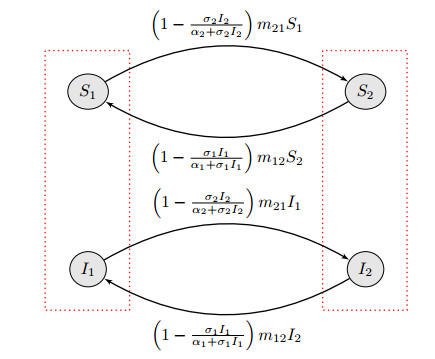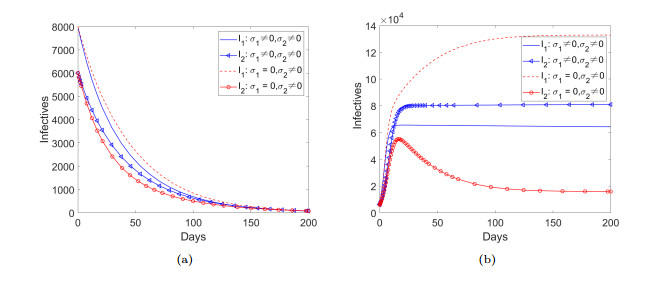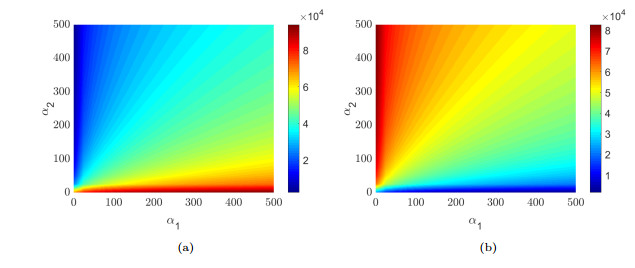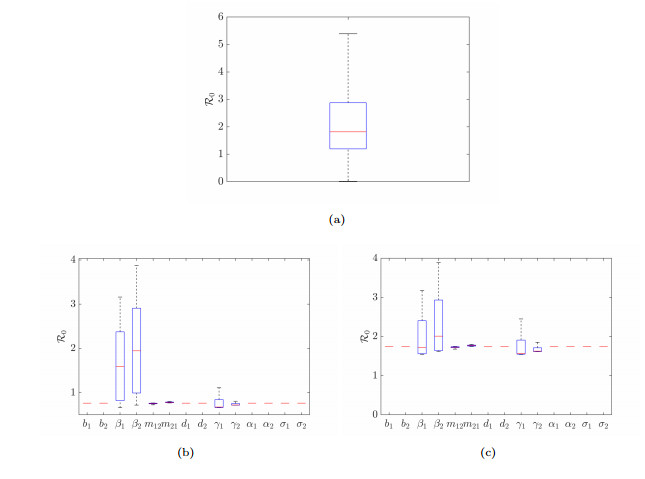|
[1]
|
L. Allen, Introduction to Mathematical Biology, Pearson/Prentice Hall, 2007.
Google Scholar
|
|
[2]
|
J. Arino, Spatio-temporal spread of infectious pathogens of humans, Infectious Disease Modelling, 2017, 2(2), 218-228. doi: 10.1016/j.idm.2017.05.001
CrossRef Google Scholar
|
|
[3]
|
J. Arino, N. Bajeux and S. Kirkland, Number of source patches required for population persistence in a source-sink metapopulation with explicit movement, Bulletin of Mathematical Biology, 2019, 81(6), 1916-1942. doi: 10.1007/s11538-019-00593-1
CrossRef Google Scholar
|
|
[4]
|
J. Arino, J. Davis, D. Hartley et al., A multi-species epidemic model with spatial migration, Mathematical Medicine and Biology, 2005, 22(2), 129-142. doi: 10.1093/imammb/dqi003
CrossRef Google Scholar
|
|
[5]
|
J. Arino and C. McCluskey, Effect of a sharp change of the incidence function on the dynamics of a simple disease, Journal of Biological Dynamics, 2010, 4(5), 490-505. doi: 10.1080/17513751003793017
CrossRef Google Scholar
|
|
[6]
|
J. Arino and S. Portet, Epidemiological implications of mobility between a large urban centre and smaller satellite cities, Journal of Mathematical Biology, 2015, 71(5), 1243-1265. doi: 10.1007/s00285-014-0854-z
CrossRef Google Scholar
|
|
[7]
|
J. Arino, C. Sun and W. Yang, Revisiting a two-patch sis model with infection during transport, Mathematical Medicine and Biology, 2016, 33(1), 29-55.
Google Scholar
|
|
[8]
|
V. O. Baroyan and L. A. Rvachev, Deterministic epidemic models for a territory with a transport network, Kibernetica, 1967, 3, 67-73.
Google Scholar
|
|
[9]
|
A. Bauman, B. Smith, E. Maibach and B. Reger-Nash, Evaluation of mass media campaigns for physical activity, Evaluation and Program Planning, 2006, 29(3), 312-322. doi: 10.1016/j.evalprogplan.2005.12.004
CrossRef Google Scholar
|
|
[10]
|
I. I. Bogoch, A. Watts, A. Thomas-Bachli et al., Potential for global spread of a novel coronavirus from China, Journal of Travel Medicine, 2020. Taaa011.
Google Scholar
|
|
[11]
|
Z. Breda, The impact of severe acute respiratory syndrome (SARS) on China's tourism sector, Tourism Research Journal, 2004, 1(2), 5-14.
Google Scholar
|
|
[12]
|
M. Chinazzi, J. T. Davis, M. Ajelli et al., The effect of travel restrictions on the spread of the 2019 novel coronavirus (2019-ncov) outbreak, medRxiv, 2020.
Google Scholar
|
|
[13]
|
M. Chinazzi, J. T. Davis, C. Gioannini et al., Preliminary assessment of the international spreading risk associated with the 2019 novel coronavirus (2019-ncov) outbreak in wuhan city, Center for Inference and Dynamics of Infectious Diseases, USA. Retrieved, 2020, 8.
Google Scholar
|
|
[14]
|
S. Collinson, K. Khan and J. Heffernan, The effects of media reports on disease spread and important public health measurements, PLoS One, 2015, 10(11), e0141423. doi: 10.1371/journal.pone.0141423
CrossRef Google Scholar
|
|
[15]
|
J. Cui, Y. Sun and H. Zhu, The impact of media on the control of infectious diseases, Journal of Dynamics and Differential Equations, 2008, 20(1), 31-53.
Google Scholar
|
|
[16]
|
J. Cui, X. Tao and H. Zhu, An SIS infection model incorporating media coverage, Rocky Mountain Journal of Mathematics, 2008, 38(5), 1323-1334. doi: 10.1216/RMJ-2008-38-5-1323
CrossRef Google Scholar
|
|
[17]
|
T. Dhirasakdanon, H. Thieme and P. van den Driessche, A sharp threshold for disease persistence in host metapopulations, Journal of Biological Dynamics, 2007, 1(4), 363-378. doi: 10.1080/17513750701605465
CrossRef Google Scholar
|
|
[18]
|
N. Ferguson, Capturing human behaviour, Nature, 2007, 446(7137), 733. doi: 10.1038/446733a
CrossRef Google Scholar
|
|
[19]
|
A. Findlater and I. I. Bogoch, Human mobility and the global spread of infectious diseases: a focus on air travel, Trends in parasitology, 2018, 34(9), 772-783. doi: 10.1016/j.pt.2018.07.004
CrossRef Google Scholar
|
|
[20]
|
E. Fromont, D. Pontier and M. Langlais, Disease propagation in connected host populations with density-dependent dynamics: the case of the Feline Leukemia Virus, Journal of Theoretical Biology, 2003, 223, 465-475. doi: 10.1016/S0022-5193(03)00122-X
CrossRef Google Scholar
|
|
[21]
|
S. Funk, E. Gilad and V. Jansen, Endemic disease, awareness, and local behavioural response, Journal of Theoretical Biology, 2010, 264(2), 501-509. doi: 10.1016/j.jtbi.2010.02.032
CrossRef Google Scholar
|
|
[22]
|
S. Funk, G. Knight and V. Jansen, Ebola: the power of behaviour change, Nature, 2014, 515(7528), 492.
Google Scholar
|
|
[23]
|
D. Gao and S. Ruan, An SIS patch model with variable transmission coefficients, Mathematical Biosciences, 2011, 232(2), 110-115. doi: 10.1016/j.mbs.2011.05.001
CrossRef Google Scholar
|
|
[24]
|
J. Ge, L. Lin and L. Zhang, A diffusive SIS epidemic model incorporating the media coverage impact in the heterogeneous environment, Discrete & Continuous Dynamical Systems-B, 2017, 22(7), 2763-2776.
Google Scholar
|
|
[25]
|
W. Hirsch, H. Hanisch and J. P. Gabriel, Differential equation models of some parasitic infections: Methods for the study of asymptotic behavior, Communications on Pure and Applied Mathematics, 1985, 38(6), 733-753. doi: 10.1002/cpa.3160380607
CrossRef Google Scholar
|
|
[26]
|
J. Jones and M. Salathe, Early assessment of anxiety and behavioral response to novel swine-origin influenza A (H1N1), PLoS One, 2009, 4(12), e8032. doi: 10.1371/journal.pone.0008032
CrossRef Google Scholar
|
|
[27]
|
K. Khan, J. Arino, R. Eckhardt et al., Global Air Traffic Patterns During the H1N1 Influenza Pandemic and their Public Health Implications, Tech. rep., The Bio.Diaspora Project (St Michael's Hospital, Toronto, Ontario, Canada), 2010.
Google Scholar
|
|
[28]
|
K. Khan, J. Arino, W. Hu et al., Spread of a novel influenza A (H1N1) virus via global airline transportation., New England Journal of Medicine, 2009, 361(2), 212-214. doi: 10.1056/NEJMc0904559
CrossRef Google Scholar
|
|
[29]
|
M. Li and Z. Shuai, Global stability of an epidemic model in a patchy environment, Canadian Applied Mathematics Quarterly, 2009, 17(1), 175-187.
Google Scholar
|
|
[30]
|
Y. Li, C. Ma and J. Cui, The effect of constant and mixed impulsive vaccination on SIS epidemic models incorporating media coverage, Rocky Mountain Journal of Mathematics, 2008, 38(5), 1437-1455. doi: 10.1216/RMJ-2008-38-5-1437
CrossRef Google Scholar
|
|
[31]
|
R. Liu, J. Wu and H. Zhu, Media/psychological impact on multiple outbreaks of emerging infectious diseases, Computational and Mathematical Methods in Medicine, 2007, 8(3), 153-164. doi: 10.1080/17486700701425870
CrossRef Google Scholar
|
|
[32]
|
A. Misra, A. Sharma and J. Shukla, Modeling and analysis of effects of awareness programs by media on the spread of infectious diseases, Mathematical and Computer Modelling, 2011, 53(5-6), 1221-1228. doi: 10.1016/j.mcm.2010.12.005
CrossRef Google Scholar
|
|
[33]
|
L. Perko, Differential Equations and Dynamical Systems, 3rd Edn, Springer-Verlag, 2001.
Google Scholar
|
|
[34]
|
M. Rahman and M. Rahman, Media and education play a tremendous role in mounting AIDS awareness among married couples in Bangladesh, AIDS Research and Therapy, 2007, 4(1), 10. doi: 10.1186/1742-6405-4-10
CrossRef Google Scholar
|
|
[35]
|
J. Sadiku, Z. Song and J. Wu, Modeling of lone star ticks with deer migration to canada, Journal of Nonlinear Modeling and Analysis, 2019, 1(4), 425-442.
Google Scholar
|
|
[36]
|
M. Salmani and P. van den Driessche, A model for disease transmission in a patchy environment, Discrete and Continuous Dynamical Systems - Series B, 2006, 6(1), 185-202. doi: 10.3934/dcdsb.2006.6.185
CrossRef Google Scholar
|
|
[37]
|
S. Samanta, S. Rana, A. Sharma et al., Effect of awareness programs by media on the epidemic outbreaks: A mathematical model, Applied Mathematics and Computation, 2013, 219(12), 6965-6977. doi: 10.1016/j.amc.2013.01.009
CrossRef Google Scholar
|
|
[38]
|
G. Schwitzer, G. Mudur, D. Henry et al., What are the roles and responsibilities of the media in disseminating health information?, PLoS Medicine, 2005, 2(7), e215. doi: 10.1371/journal.pmed.0020215
CrossRef Google Scholar
|
|
[39]
|
H. Smith and P. Waltman, The Theory of the Chemostat - Dynamics of Microbial Competition, Cambridge University Press, 1995.
Google Scholar
|
|
[40]
|
C. Sun, W. Yang, J. Arino and K. Khan, Effect of media-induced social distancing on disease transmission in a two patch setting, Mathematical Biosciences, 2011, 230(2), 87-95. doi: 10.1016/j.mbs.2011.01.005
CrossRef Google Scholar
|
|
[41]
|
H. Thieme, Mathematics in Population Biology, Princeton Series in Theoretical and Computational Biology, Princeton University Press, 2003.
Google Scholar
|
|
[42]
|
P. van den Driessche and J. Watmough, Reproduction numbers and subthreshold endemic equilibria for compartmental models of disease transmission, Mathematical Biosciences, 2002, 180, 29-48. doi: 10.1016/S0025-5564(02)00108-6
CrossRef Google Scholar
|
|
[43]
|
M. Wakefield, B. Loken and R. Hornik, Use of mass media campaigns to change health behaviour, The Lancet, 2010, 376(9748), 1261-1271. doi: 10.1016/S0140-6736(10)60809-4
CrossRef Google Scholar
|
|
[44]
|
A. Wang and Y. Xiao, A Filippov system describing media effects on the spread of infectious diseases, Nonlinear Analysis: Hybrid Systems, 2014, 11, 84-97. doi: 10.1016/j.nahs.2013.06.005
CrossRef Google Scholar
|
|
[45]
|
Q. Wang, L. Zhao, R. Huang et al., Interaction of media and disease dynamics and its impact on emerging infection management, Discrete & Continuous Dynamical Systems-Series B, 2015, 20(1).
Google Scholar
|
|
[46]
|
W. Wang and X. Zhao, Threshold dynamics for compartmental epidemic models in periodic environments, Journal of Dynamics and Differential Equations, 2008, 20(3), 699-717. doi: 10.1007/s10884-008-9111-8
CrossRef Google Scholar
|
|
[47]
|
Y. Xiao, S. Tang and J. Wu, Media impact switching surface during an infectious disease outbreak, Scientific Reports, 2015, 5, 7838. doi: 10.1038/srep07838
CrossRef Google Scholar
|
|
[48]
|
Q. Yan, S. Tang, S. Gabriele and J. Wu, Media coverage and hospital notifications: Correlation analysis and optimal media impact duration to manage a pandemic, Journal of Theoretical Biology, 2016, 390, 1-13. doi: 10.1016/j.jtbi.2015.11.002
CrossRef Google Scholar
|
|
[49]
|
M. Young, G. Norman and K. Humphreys, Medicine in the popular press: the influence of the media on perceptions of disease, PLoS One, 2008, 3(10), e3552. doi: 10.1371/journal.pone.0003552
CrossRef Google Scholar
|
|
[50]
|
X. Zhao, Dynamical Systems in Population Biology, Springer-Verlag, 2003.
Google Scholar
|






 DownLoad:
DownLoad:





